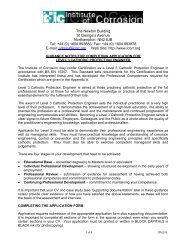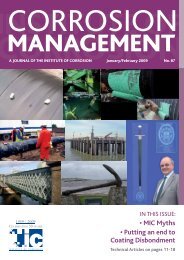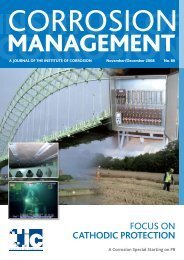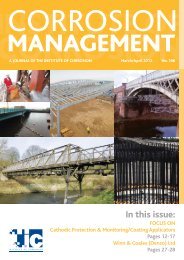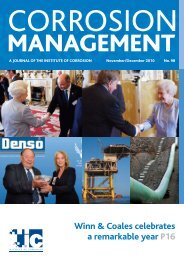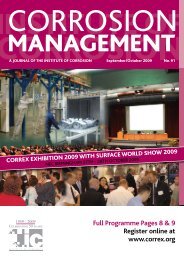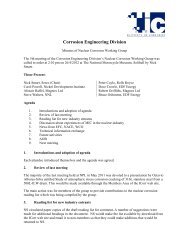In this issue: - the Institute of Corrosion
In this issue: - the Institute of Corrosion
In this issue: - the Institute of Corrosion
You also want an ePaper? Increase the reach of your titles
YUMPU automatically turns print PDFs into web optimized ePapers that Google loves.
TECHNICALARTICLE<br />
Table 1. Brush plating process for <strong>the</strong> nickel coatings on Ti-6Al-4V shown in Figure 3.<br />
Step Operation Material Conditions<br />
1 Abrade Scotch-Brite® Wet with Etch/Activate Solution<br />
2 Etch Etch/Activate 14 V anodic, 10 seconds<br />
3 Activate Solution 4 – 8 V cathodic, 1 minute<br />
Figure 2. Anode for brush plating MMC<br />
onto a ring or pipe.<br />
Results and Discussion<br />
Figure 3 shows a cross-section <strong>of</strong> a brush plated<br />
nickel coating on a Ti-6Al-4V coupon 1 . The<br />
interface between <strong>the</strong> titanium and nickel is<br />
free <strong>of</strong> bulk oxide. Figure 3 shows <strong>the</strong> smooth<br />
surface <strong>of</strong> <strong>the</strong> original titanium was<br />
microetched during pretreatment. Nickel<br />
plated readily into <strong>the</strong> microroughness features.<br />
The adhesion was checked by tape and bend<br />
tests. The nickel deposit did not separate from<br />
<strong>the</strong> titanium alloy substrate during tape or<br />
bend tests. Thin panels <strong>of</strong> Ti-6Al-4V and Ti-<br />
6Al-6V-2Sn broke in one, 180 bend without<br />
separation or peeling <strong>of</strong> <strong>the</strong> deposit. Grade<br />
2 titanium can be bent a full 180° without<br />
breaking. The bend test was more rigorous in<br />
revealing low adhesion than <strong>the</strong> tape test.<br />
Figure 3. Cross-section photomicrograph <strong>of</strong> nickel<br />
deposit on titanium 6Al-4V. Titanium surface<br />
etch/activated by procedure in Table 1.<br />
Several factors contribute to <strong>the</strong> excellent<br />
adhesion exhibited by <strong>the</strong> structure in Figure<br />
3, mechanical interlocking, increased surface<br />
area, and lack <strong>of</strong> an oxide film. These three<br />
attributes were generated during <strong>the</strong> brush<br />
plating process. Brush plating is particularly<br />
suited for generating <strong>the</strong>se three attributes<br />
due to <strong>the</strong> small volume <strong>of</strong> electrolyte, to close<br />
contact between <strong>the</strong> anode and <strong>the</strong> cathode,<br />
and rapidity with which electrolytes can be<br />
switched from activation to strike plating.<br />
The plating procedure used to make <strong>the</strong><br />
deposit in Figure 3 is given in Table 1. Important<br />
considerations for <strong>this</strong> process are to keep <strong>the</strong><br />
titanium under potential control at all times,<br />
<strong>the</strong> plated area is 100% covered by <strong>the</strong> wrapped<br />
anode, rapid switching from anodic to cathodic,<br />
no rinsing between steps, and <strong>the</strong> etch/activate<br />
solution is not reused. The nickel coating on<br />
titanium can be <strong>the</strong> final coating for many<br />
applications. As discussed next it may be used<br />
as a bonding layer for applying o<strong>the</strong>r coatings<br />
to titanium alloys.<br />
Adhesion – The adhesion to Ti-6Al-4V <strong>of</strong> nickel<br />
plated and layers overplated on nickel was<br />
tested by several methods. The adhesion was<br />
acceptable when checked by <strong>the</strong> tape and chisel<br />
tests in AMS 2451A. The bend test <strong>of</strong> ASTM B571<br />
showed <strong>the</strong> Ti-6Al-4V substrate broke before<br />
adhesion failed. Adhesion was satisfactory in<br />
heat/quench (250° C into RT water), scribe,<br />
and chisel-knife test given in B571. The nickel<br />
to Ti-6Al-4V tensile adhesion was > 6,000 psi<br />
measured according to ASTM C633.<br />
The adhesion <strong>of</strong> cobalt chromium-carbide<br />
composite deposits to Ti-6Al-4V and steel<br />
substrates was enhanced by an intermediate<br />
nickel bonding layer. The MMC deposit on Ti-<br />
6Al-4V alloy and o<strong>the</strong>r materials (e.g. steel)<br />
passed tape, bending and machining tests with<br />
good adhesion.<br />
The MMC did not flake <strong>of</strong>f <strong>the</strong> base after ten<br />
<strong>the</strong>rmal cycles between room temperature<br />
and 800° C. This could be attributed to a small<br />
differ ence between <strong>the</strong> <strong>the</strong>rmal expansion<br />
coefficients <strong>of</strong> <strong>the</strong> coating and <strong>the</strong> base<br />
materials 3 .<br />
Mechanism – The electrochemical deposition<br />
reactions in <strong>the</strong> cobalt sulfate based electrolyte are:<br />
H 2<br />
O<br />
4 Strike Plate Acid Nickel 8 - 18 V cathodic, 0.078 A*hr/cm 2<br />
Co 2+ + 2e -<br />
½O 2<br />
+ 2H + + 2e - on <strong>the</strong> anode<br />
Co on <strong>the</strong> cathode<br />
Chromium carbide powder did not dissolve in<br />
<strong>the</strong> solution to form ions (cations or anions).<br />
The carbide particle was electrophoretically codeposited<br />
along with cobalt on <strong>the</strong> cathode.<br />
These particles were small, in <strong>the</strong> range <strong>of</strong><br />
1 – 6 μm. Such small particles normally tend<br />
to agglomerate to each o<strong>the</strong>r. Therefore, it is<br />
important to use right agitation or stirring to<br />
break or prevent agglomeration and keep <strong>the</strong><br />
particles highly suspended and dispersed in <strong>the</strong><br />
solution for electrophoresis.<br />
Particle Distribution – The distribution <strong>of</strong><br />
carbide particles throughout <strong>the</strong> metal matrix<br />
was examined using optical micrographs and<br />
SEM images <strong>of</strong> cross-sections <strong>of</strong> plated parts.<br />
A uniform distribution <strong>of</strong> ceramic particles in<br />
<strong>the</strong> metal matrix is shown in Figures 4 - 6. The<br />
rounded or squared asperities are chromium<br />
carbide particles encased in metallic cobalt.<br />
The micro-graphed deposits are as polished,<br />
without a microetch.<br />
The surface <strong>of</strong> <strong>the</strong> as-plated composite<br />
had a matte grey appearance. X-ray<br />
fluorescence analysis <strong>of</strong> <strong>the</strong> distribution <strong>of</strong> Cr 3<br />
C 2<br />
across <strong>the</strong> deposit was uniform within ±3 wt.%.<br />
The Cr 3<br />
C 2<br />
content in <strong>the</strong> deposit was as high as<br />
50 wt.%. The carbide content was controlled<br />
between 10 and 50 wt.% through adjusting<br />
deposition parameters. Since different end<br />
use applications may require different content<br />
<strong>of</strong> Cr 3<br />
C 2<br />
<strong>the</strong> feasibility <strong>of</strong> controllable Cr 3<br />
C 2<br />
content is important.<br />
Figure 4. Optical micrograph <strong>of</strong> cross-section<br />
<strong>of</strong> Co-Cr 3<br />
C 2<br />
deposit on Ni-preplated Ti-6AI-<br />
4V alloy.<br />
Figure 5. Optical micrograph <strong>of</strong> <strong>the</strong> Co-Cr 3<br />
C 2<br />
deposit at 1000x magnification.<br />
Figure 6. Secondary scanning electron<br />
microscope image <strong>of</strong> a Co-Cr 3<br />
C 2<br />
deposit in<br />
cross-section at 2000x magnification.<br />
9



